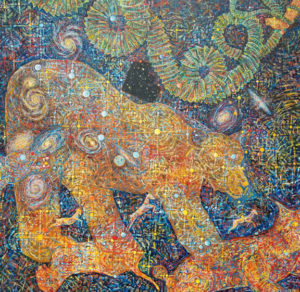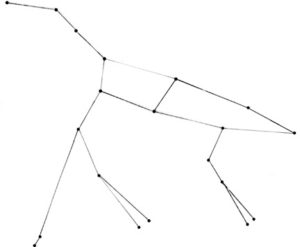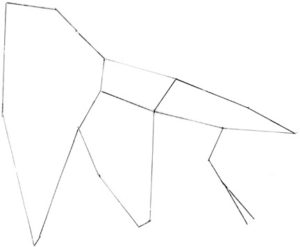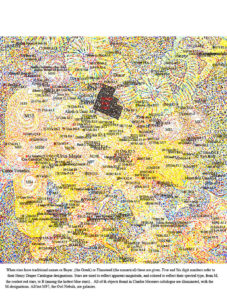I have a few bold claims and postures about this painting

- For the past 2000+ years, everyone has misidentified Ursa Major, the Great Bear
- No painting ever completed has as its subject a larger total mass than this one.
- Chicago should adopt Chi Ursa Major as the official City Star.
1.
Descriptions of Ursa Major (the Great Bear) usually contain qualifiers like, “it doesn’t really look like a bear,” or, “you can kinda see a bear if you imagine a little.”
Nonsense. The bear is as clear as day, and it’s always been there, but every documented description of it since antiquity has omitted a single star that renders the Bear into a freakish beast. It’s really just the tail that does it in. If, as is the standard description, the handle of the Big Dipper is the tail of the Bear, it extends approximately the same length as the Bear’s body.
Real bears have little tiny nubs of tails, maybe a couple inches.
So where did this Fake News Ursa Major come from? It’s been with us a long time.
Much of what we know about ancient astronomy came from Ptolemy, a Greek citizen living in Egypt about 100 AD. He was not the first (not by a long shot — it’s hard to imagine ancient man NOT seeing things in the sky) to describe the Constellations, but his descriptions provide the most coherent, complete ancient world star catalog. Indeed, his catalog was almost entirely based on a now-lost (thanks, no doubt, to Ptolemy’s one-upmanship) circa 150 BC catalog by Hipparchus.
Ptolemy described 48 constellations (there are 88 Modern Constellations, by comparison), writing all that was knowable about the stars.
HIs list of stars in Ursa Major is pretty much the same as is recognized today.
In Ptolemy’s account, some stars were listed as unfigured – outside of the constellations. Some of these stars were later incorporated into constellations by observers who wished to fill the space between the 48 constellations listed by Ptolemy.
One of these stars, now known as Cor Caroli (”Heart of Charles”), is, I argue, and always has been, part of the Great Bear, though it was not documented as such.
My thesis here, comes down to this.
This is not a bear:

This, however: pretty much a bear.

The difference is a single star, that was basically just considered an unincorporated outpost.
In my proposed model, the handle of the Dipper is the backbone of the bear, strong, firm. The bow of the dipper corresponds to the rib cage, more or less. The size of the bear increases by about 50%, so it is both more Bear-like and larger than that Tailed Thin. It is a massive, powerful Bear. Sounds like a win-win.
Cor Caroli visible magnitude is 2.89, which would make it the seventh brightest star in Ursa Major. All six brighter stars are in the Big Dipper, and only one of those seven is ever so slightly dimmer than Cor Caroli at peak magnitude.
Cor Caroli is the same spectral class — the color — as five of the seven Big Dipper stars, which looks like a bright, almost white, blue.
It’s also close to the Big Dipper — clearly separate from it’s 7 Star Majesty, but still about as close as the much dimmer Muscida, usually depicted as the Bear’s nose. However, Cor Caroli is not, apparently, part of the Ursa Major Moving Group, a set of stars that share a common origin but are moving in different directions.
So why would Ptolemy skip Cor Caroli when attributing stars?
Ptolemy was a city man. It’s possible he never saw an actual bear. It’s possible he heard stories of them as long tailed. It’s possible he made it less on purpose because he was petty hated bears. I’m afraid we’ll never know.
It’s also fascinating to me that, when Johannes Hevelius put Cor Caroli in a new constellation in the 17th century, he put it in the Hunting Dogs, Canes Ventatici.
Consider the bear in the historical context of mankind. It was, rightly, to be feared.
For thousands of years, bears distinctly had the advantage. SIze, strength, speed, weapons. Meetings of man vs bear were mostly men running, scattering, and hoping the bear didn’t chose them.
That changed with the dog.
Dogs, in one form or another, have lived along man for over 30,000 years. Their presence would have significantly changed the matrix of the man v bear meeting.
By taking what had been yanked from the Bear so long ago, and giving it to the Dog, Hevelius further subjugated the Great Bear, even if accidentally.
2.
This painting contains several hundred galaxies, several hundred stars, 9 assorted creatures, one planetary nebula, two hats, and a few other things I’m not telling you about. I realize executing a painting with a larger (by mass) subject matter would be easy enough to design. This wasn’t my intention, but a fun aside. A basic schematic is:

3.
The Committee to Select Chi Ursa Major as the Official Star of Chicago is hereby founded.
Chicago’s association with bears is embedded in stone. Da Bears. Da Cubbies. There are a couple other Chicago-relevant constellations — the River comes to mind– but the Bear is, clearly the best. I’m a Sox fan, but was working on this painting while the Cubs were doing their little World Series thing, and I briefly considered putting a Cubs hat on the bear. Chi Ursa Major is visible from Chicago on a clear Summer Night.
Oh, sadly, the Chi in Chi Ursa Major is pronounced more like ”kai.”
Anyway, message me if you want to join the committee.
Thanks for reading!